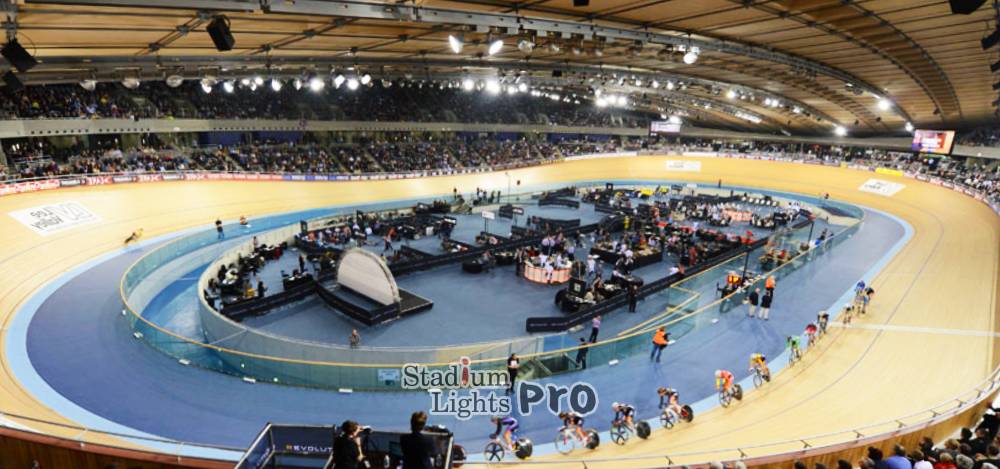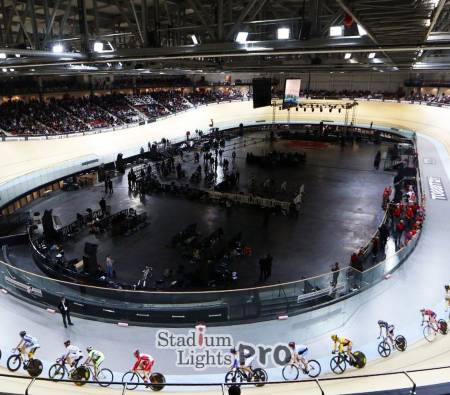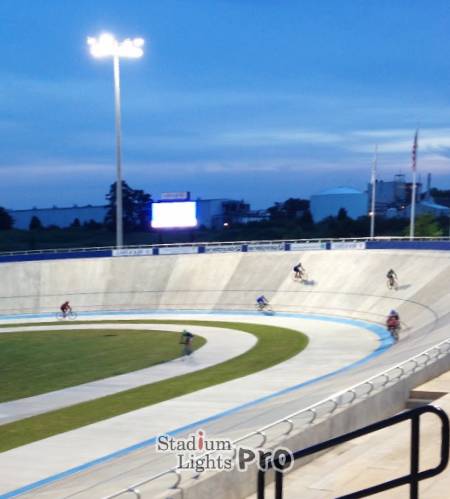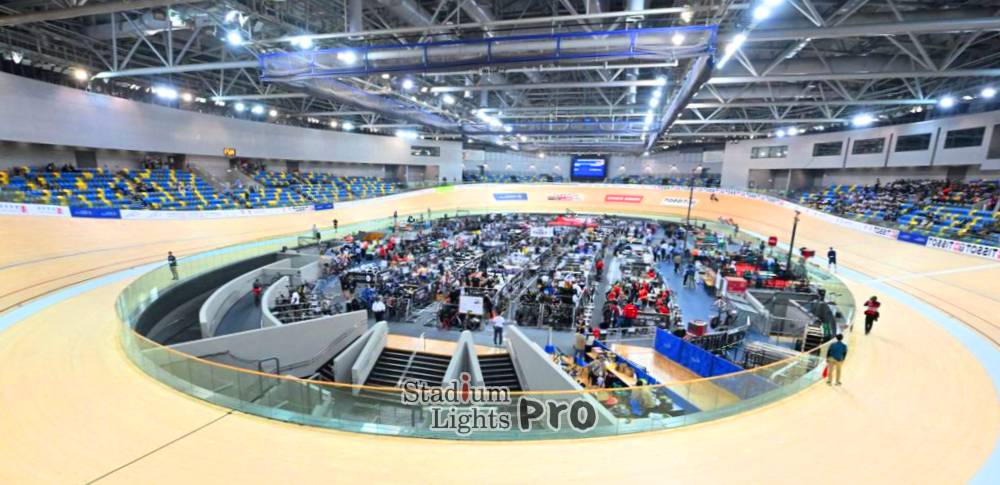Velodromes are indoor arenas specifically designed for competitive cycling events. These venues require high-quality lighting systems to ensure the safety of athletes and the enjoyment of spectators. The lighting system plays a critical role in maintaining proper visibility, particularly when events take place in the evening or under less natural light conditions. However, installing and maintaining these lighting systems can be costly. The total expense of velodrome lighting is influenced by several factors, including the type of lighting used, labor and installation costs, maintenance expenses, and the cost of electricity. Furthermore, there are ways to reduce these costs, such as through energy-efficient lighting systems and subsidies from government and utility programs.
In this detailed breakdown, we will explore all aspects of velodrome lighting costs, providing detailed insights into the factors that contribute to the overall expenses and how these costs can be optimized.

Table of Contents
ToggleTypes of Lighting for Velodromes
Lighting technology has evolved over the years, and the type of lighting system chosen for a velodrome can significantly impact the overall cost. The three primary types of lighting systems used in velodromes are incandescent lighting, fluorescent lighting, and LED lighting. Each of these types of lights has its advantages and disadvantages, especially when considering factors such as cost, energy efficiency, and lifespan.
Incandescent Lighting
Incandescent lighting was once the standard for lighting sports arenas, including velodromes. These bulbs are relatively inexpensive upfront, with basic incandescent bulbs costing between $1 and $5 per fixture. However, they are far less energy-efficient than modern lighting systems. Incandescent bulbs typically consume between 60 and 100 watts, leading to higher electricity costs compared to energy-efficient options.
While the initial cost for installation might seem low, the operational costs of incandescent lighting are high. In a velodrome that operates for an average of 10 hours per day, an incandescent bulb would likely cost anywhere from $10 to $20 per year in electricity alone. For a velodrome with hundreds of bulbs, this can add up quickly. Additionally, incandescent bulbs have relatively short lifespans—usually only around 1,000 hours—meaning they need frequent replacements, which increases both material and labor costs. As a result, this lighting option is becoming obsolete for large venues like velodromes.
Fluorescent Lighting
Fluorescent lighting offers a more energy-efficient alternative to incandescent bulbs. Fluorescent fixtures typically cost between $5 and $20 per bulb. These bulbs use less energy, consuming around 30 to 60 watts each, making them a more cost-effective option than incandescent bulbs in terms of electricity consumption. Fluorescent lights also have longer lifespans, generally ranging from 10,000 to 20,000 hours, which reduces the frequency of bulb replacements.
In terms of operational costs, a fluorescent bulb might consume between $500 and $1,000 in electricity annually, depending on the number of bulbs and how often the velodrome is used. However, they are not entirely without drawbacks. Fluorescent lights tend to degrade in quality over time, and they can flicker, which may be distracting for athletes and spectators. Furthermore, they still consume more electricity than modern LED systems, making them less efficient in the long term.
LED Lighting
 LED (Light Emitting Diode) lighting has emerged as the industry standard for high-performance lighting systems in velodromes. Although the initial cost of installing an LED system can be higher than that of incandescent or fluorescent lighting, the long-term savings far outweigh the upfront investment. LEDs have become the preferred choice due to their energy efficiency, long lifespan, and lower maintenance costs.
LED (Light Emitting Diode) lighting has emerged as the industry standard for high-performance lighting systems in velodromes. Although the initial cost of installing an LED system can be higher than that of incandescent or fluorescent lighting, the long-term savings far outweigh the upfront investment. LEDs have become the preferred choice due to their energy efficiency, long lifespan, and lower maintenance costs.
The cost of LED fixtures typically ranges from $50 to $150 per bulb, depending on the specifications and brand. While this is higher than incandescent or fluorescent lighting, LEDs consume only 10 to 40 watts of power per fixture. In a typical velodrome with 200 to 300 fixtures, the electricity cost of operating LEDs can be as low as $2,000 to $5,000 annually, compared to $20,000 or more for incandescent bulbs.
One of the most significant advantages of LED lighting is its lifespan. With proper maintenance, LED bulbs can last up to 50,000 to 100,000 hours. This means that a well-maintained LED system could last upwards of 10 years before requiring significant replacement. This longevity helps reduce the total cost of ownership, as the need for frequent replacements and repairs is minimized.
Lighting System Costs
| Lighting Type | Initial Cost per Fixture | Energy Consumption (per fixture) | Lifespan | Annual Electricity Cost (per fixture) | Maintenance & Replacement Costs | Advantages | Disadvantages |
|---|---|---|---|---|---|---|---|
| Incandescent | $1 – $5 | 60 – 100 watts | ~1,000 hours | $10 – $20 | High due to frequent bulb replacement | Low initial cost, widely available | High energy consumption, short lifespan |
| Fluorescent | $5 – $20 | 30 – 60 watts | 10,000 – 20,000 hours | $500 – $1,000 | Moderate, less frequent than incandescent | More energy-efficient than incandescent, longer lifespan | Flickering, degradation over time, higher electricity cost than LED |
| LED | $50 – $150 | 10 – 40 watts | 50,000 – 100,000 hours | $2,000 – $5,000 | Low, only occasional replacement | Very energy-efficient, long lifespan, lower maintenance costs | Higher upfront cost, specialized installation |
Comparison of Lighting Systems in a Velodrome
| Category | Incandescent Lighting | Fluorescent Lighting | LED Lighting |
|---|---|---|---|
| Initial Installation Cost | $30,000 – $60,000 | $40,000 – $80,000 | $60,000 – $150,000 |
| Energy Consumption | High | Moderate | Low |
| Annual Electricity Cost (for 200 fixtures) | $20,000+ | $10,000 – $15,000 | $2,000 – $5,000 |
| Fixture Lifespan | 1,000 hours | 10,000 – 20,000 hours | 50,000 – 100,000 hours |
| Maintenance & Repair Costs (Annual) | $5,000 – $10,000 | $3,000 – $7,000 | $1,000 – $3,000 |
| Total Annual Lighting Costs | $25,000 – $35,000 | $13,000 – $22,000 | $3,000 – $8,000 |
| Government Subsidy Potential | Low | Moderate | High |
| Energy Efficiency Rating | Low | Moderate | Very High |
| Environmental Impact | High | Moderate | Low |
Labor Costs for Installation and Maintenance
Labor is another cost factor when it comes to lighting a velodrome. Labor costs are incurred both during the installation of the lighting system and through ongoing maintenance activities. The complexity of the lighting system, the type of bulbs used, and the frequency of maintenance all affect these costs.
Installation Labor Costs
 The installation of a lighting system in a velodrome requires skilled electricians who are capable of handling the intricate electrical work and ensuring that the lighting system is properly wired, aligned, and tested. The installation of LED lighting, for example, requires the expertise of electricians who are familiar with the unique characteristics of LED fixtures and the technology required to support them. The total cost for installing a lighting system can vary greatly depending on the size of the velodrome and the complexity of the system.
The installation of a lighting system in a velodrome requires skilled electricians who are capable of handling the intricate electrical work and ensuring that the lighting system is properly wired, aligned, and tested. The installation of LED lighting, for example, requires the expertise of electricians who are familiar with the unique characteristics of LED fixtures and the technology required to support them. The total cost for installing a lighting system can vary greatly depending on the size of the velodrome and the complexity of the system.
On average, the cost of labor for installing a lighting system in a medium-sized velodrome can range from $10,000 to $25,000. Larger venues with more complex lighting setups may incur labor costs upwards of $50,000. The labor costs associated with installing the lighting system depend on factors such as the number of fixtures being installed, the difficulty of the installation process, and the labor rates in the region.
Ongoing Labor Costs for Maintenance
Once the lighting system is in place, regular maintenance is required to ensure that the system continues to function optimally. This maintenance includes tasks such as cleaning the fixtures, inspecting the wiring, replacing burned-out bulbs, and repairing any electrical faults. The cost of ongoing labor for maintenance can vary depending on the size of the lighting system, the type of bulbs used, and the frequency of maintenance required.
For example, routine maintenance on a small to medium-sized velodrome may cost anywhere from $2,000 to $5,000 annually. This includes labor for minor repairs, fixture cleaning, and occasional bulb replacements. However, for larger velodromes or older systems, maintenance costs can increase to $10,000 or more annually, especially if the system requires frequent repairs or if the lights are not energy-efficient.
Installation Costs of Lighting Systems
The cost of installing a lighting system in a velodrome includes not only the cost of materials but also the associated installation services. This can be a substantial expense, particularly for larger venues that require a more intricate setup or additional features.
Materials and Equipment Costs
The materials for a velodrome lighting system include the light fixtures, wiring, electrical components (such as transformers and dimming systems), and any necessary support structures for mounting the lights. For a basic setup, the cost of materials can range from $30,000 to $60,000. If the system includes additional features, such as automated lighting controls or dimming systems, the material costs can rise significantly, reaching anywhere from $100,000 to $200,000 or more for a large velodrome.
LED lights are more expensive than incandescent or fluorescent bulbs, but their energy savings and longevity can make them a more cost-effective choice in the long run. A velodrome might need anywhere from 150 to 500 individual light fixtures, depending on its size and the specific lighting requirements for the track and seating areas.
Permits and Compliance Costs
In many jurisdictions, installing or upgrading lighting systems in public venues requires obtaining various permits and ensuring compliance with local building codes and safety standards. These costs can vary depending on the location of the velodrome and the complexity of the installation. The cost of obtaining permits can range from $500 to $5,000 or more, depending on the region and the type of lighting system being installed.
In addition to permits, velodrome owners may need to comply with certain environmental and energy efficiency standards, which could necessitate additional investments in specialized equipment.

Operating Costs of Velodrome Lighting
Operating costs for lighting systems are driven by electricity consumption, though there are also ongoing costs for maintaining and operating the system.
Electricity Costs
The energy consumed by the lighting system is determined by the type of lights used, the size of the venue, and how often the lighting system is in use.
LED lighting is the most energy-efficient option available, consuming between 10 and 40 watts per fixture. This leads to much lower electricity costs compared to traditional incandescent or fluorescent bulbs, which use between 60 and 100 watts per fixture. A typical velodrome that operates for 10 hours per day could see electricity costs of $200 to $500 annually per LED fixture. With hundreds of fixtures in place, this can lead to annual savings of tens of thousands of dollars compared to incandescent or fluorescent lighting.
For a large velodrome with 200 to 500 LED fixtures, the total annual electricity cost might range from $40,000 to $100,000, depending on the specific fixtures used and how much the venue operates.
Control Systems for Energy Efficiency
Installing energy-efficient lighting control systems can further reduce operating costs by adjusting the intensity of the lights based on the time of day or the type of event. These automated systems can help reduce energy consumption during low-traffic times or when lighting is not needed at full brightness. For example, a dimming system might be used to lower the lighting during practice sessions or smaller events, while full brightness can be used during major competitions.
The initial investment for energy management systems can range from $10,000 to $50,000, but the savings in energy consumption can help pay back this investment over time.
Maintenance and Repair Costs
All lighting systems require ongoing maintenance to ensure optimal performance. Regular maintenance helps reduce the likelihood of costly repairs and can extend the lifespan of the lighting system.
Regular Maintenance
Routine maintenance tasks include cleaning the fixtures, inspecting wiring and electrical components, and replacing burnt-out bulbs or malfunctioning parts. Regular maintenance is particularly important for preventing minor issues from becoming major problems.
For a mid-sized velodrome, annual maintenance costs might range from $2,000 to $5,000. Larger venues or older lighting systems, especially those using traditional incandescent or fluorescent bulbs, may incur higher maintenance costs.
Repair Costs
In addition to routine maintenance, repairs are sometimes needed to address faults in the system. Repair costs can vary depending on the severity of the issue. For example, repairing a faulty light fixture or replacing a bulb might cost a few hundred dollars. However, repairing major components, such as transformers or electrical control systems, can cost thousands of dollars. Velodromes that use older systems, such as incandescent or fluorescent lighting, may experience more frequent repairs than those that have switched to LED technology, which generally requires fewer repairs.
Reducing Overall Lighting Costs
While the costs of velodrome lighting can add up quickly, there are various strategies that can be implemented to reduce both upfront and ongoing expenses. These strategies include transitioning to energy-efficient lighting systems, implementing automated control systems, performing regular maintenance, and taking advantage of available subsidies and grants. By focusing on these key areas, velodrome owners can not only reduce their operating costs but also improve the overall sustainability of their venue.
Energy-Efficient Lighting Solutions
One of the most effective ways to reduce velodrome lighting costs is to invest in energy-efficient lighting systems, particularly LED lighting. Although the initial investment for LED fixtures is higher than traditional incandescent or fluorescent options, the long-term financial benefits are significant. LEDs consume far less electricity, and their long lifespan reduces the frequency of replacements, making them a cost-effective choice in the long run.
LED lights use up to 80% less energy compared to traditional incandescent bulbs. For instance, while an incandescent bulb consumes around 60-100 watts, an LED fixture can provide the same level of brightness using only 10-40 watts of power. This significant reduction in energy consumption translates directly into lower electricity bills. Furthermore, LED fixtures last much longer than traditional lighting options, with lifespans ranging from 50,000 to 100,000 hours. This longevity means that the number of bulb replacements required over the years is dramatically reduced, thus cutting down on maintenance and labor costs associated with replacing failed bulbs.
In velodromes, which often have numerous lighting fixtures throughout the venue, the cost savings from switching to LED lighting can be substantial. For example, a velodrome that operates 10 hours a day and uses 200 LED fixtures could save thousands of dollars annually in electricity costs compared to using traditional incandescent lighting. Over the course of 10 years, these savings can easily outweigh the higher initial cost of LED fixtures, making the upfront investment worthwhile.
Use of Automated Control Systems
Another strategy to reduce lighting costs is the implementation of automated control systems. These systems allow velodrome operators to manage lighting intensity more effectively and optimize energy consumption. By using sensors and automated controls, the lighting system can adjust based on factors such as time of day, ambient light levels, or event requirements.
For instance, automated systems can dim the lights during low-activity periods, such as during practice sessions or when there are fewer spectators in the stands. In contrast, during events that require full brightness, the system can automatically increase the lighting intensity. Such automated dimming or switching off of lights when they are not needed helps to save significant amounts of energy.
In addition, automated control systems can be programmed to switch off lighting in areas that are not in use. For example, the seating sections or corridors may not need lighting during specific hours or when events are not in progress. This precision in lighting management reduces overall electricity consumption while maintaining adequate visibility and safety standards.
The initial installation of automated control systems typically adds to the overall cost of the lighting system. However, the reduction in energy consumption can lead to significant savings over time. In some cases, the savings from energy efficiency can allow for a payback on the investment within a few years. Moreover, automated systems can be designed to integrate with the building’s broader energy management infrastructure, further contributing to the venue’s overall sustainability goals.
Regular Maintenance and Preventive Care
A well-maintained lighting system operates more efficiently, ensuring that each fixture works at its best and minimizing unnecessary energy consumption. Routine maintenance plays a key role in reducing long-term lighting costs by preventing issues before they become expensive problems. Regular inspections, cleaning, and part replacements can extend the lifespan of lighting fixtures and improve their performance, preventing excess energy use.
For example, dust and dirt can accumulate on lighting fixtures, which can decrease their brightness and efficiency. Regular cleaning of the light bulbs and their fixtures helps maintain optimal lighting conditions and reduces the amount of energy required to achieve the desired brightness. In addition, routine inspections can identify issues such as faulty wiring, aging components, or malfunctioning fixtures that might increase energy consumption. Early detection of such problems allows for timely repairs, preventing the need for costly and disruptive major repairs later on.
Another aspect of maintenance is ensuring that bulbs are replaced promptly when they burn out. Leaving faulty or dim lights in place can force other parts of the system to work harder, increasing energy consumption. By replacing bulbs at the right time, velodrome operators can maintain a consistently high level of lighting performance while minimizing energy waste.
Preventive care is particularly important for LED lighting systems, as they are designed to last a long time. Regular maintenance can extend the life of the system even further and help prevent premature failure of individual components. Proactive maintenance practices, such as checking wiring, fixtures, and electrical connections, can save on both repair and replacement costs, as well as ensure that the system continues to operate at peak efficiency.
By committing to regular maintenance and preventive care, velodrome owners can avoid unnecessary repair costs, minimize downtime, and keep operational costs low. While maintenance requires some investment, the savings gained from avoiding major repairs or premature replacements are more than worth the effort.
Subsidies and Grants
Governments and utility companies often offer subsidies, rebates, or grants to encourage the adoption of energy-efficient technologies, including lighting systems. These financial incentives can help offset the higher initial costs associated with upgrading to LED lighting or installing automated control systems. For velodrome owners, taking advantage of such subsidies can significantly reduce the overall cost of transitioning to more energy-efficient lighting solutions.
Many local and national governments offer programs that provide financial support for the adoption of energy-efficient technologies in public venues like sports arenas and community centers. These programs are designed to promote sustainability and reduce overall energy consumption. In some regions, utility companies may offer rebates to businesses and institutions that upgrade to LED lighting, which helps them meet energy-saving targets and reduce the strain on the electrical grid.
To apply for subsidies or grants, velodrome owners typically need to submit an application outlining the planned lighting upgrade, including the expected energy savings, the type of lighting to be installed, and the projected costs. The application process can vary by region, but it usually requires providing detailed specifications of the lighting system, the number of fixtures, and the expected reduction in electricity consumption. In some cases, utility companies may require an energy audit to assess the potential energy savings before approving the grant or subsidy.
The requirements for applying for subsidies or grants can differ depending on the specific program. Some programs may require that the lighting system meet certain energy efficiency standards, such as those set by ENERGY STAR or similar organizations. Others may have specific guidelines for the types of fixtures or control systems that are eligible for financial assistance. It is important for velodrome operators to thoroughly research available programs and ensure they meet the necessary criteria before applying.
Taking advantage of these financial incentives can significantly reduce the overall cost of upgrading lighting systems, making energy-efficient solutions more affordable. Even when subsidies only cover a portion of the upfront costs, they can still provide valuable savings, helping velodrome owners make the switch to energy-efficient lighting without breaking their budget.
Conclusion
The cost of lighting a velodrome is influenced by multiple factors, including the type of lighting used, installation and labor costs, ongoing energy consumption, and the need for maintenance and repairs. While the initial cost of LED lighting may be higher than traditional incandescent or fluorescent options, the long-term benefits—such as energy savings, longer lifespans, and reduced maintenance—make it the most cost-effective choice for velodrome lighting. By implementing energy-efficient lighting systems, regular maintenance practices, and taking advantage of subsidies, velodrome owners can significantly reduce the overall cost of their lighting systems.

